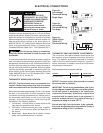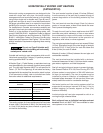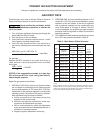
13
HORIZONTALLY VENTED UNIT HEATERS
(CATEGORY III)
Horizontal venting arrangements are designed to be
used with single wall vent pipe. Horizontal venting
arrangements must terminate external to the building
using either single wall or double wall (Type B) vent. If
single wall vent pipe is used, it must be constructed of
26 gauge galvanized steel or a material of equivalent
durability and corrosion resistance for the vent system.
For installations in Canada, use corrosion resistant and
gas-tight, listed vent pipe conforming with local building
codes, or in the absence of local building codes, with
current CAN/CGA-B149.1, Installation Codes for Natural
Gas Burning Appliances and Equipment or CAN/CGA-
B149.2, Installation Codes for Propane Gas Burning
Appliances and Equipment. See Figures 7, 8A and 9A for
special installation requirements regarding these venting
conditions.
Do not use Type B (double wall)
vent internally within the building on horizontally
vented power vented units!
If double wall venting is used, components which are UL
Listed and approved for Category III positive pressure
venting systems MUST be used.
A Breidert Type L, Fields Starkap, or equivalent vent cap
must be supplied by the customer for each power vented
unit. The vent pipe diameter MUST be as specified in
Table 1 (“D” Dia. Flue Opening). All unit sizes are factory
equipped with the required fl ue size collar; attach in place
(if not mounted to outlet); refer to included vent collar
instruction sheet for additional requirements.
Vent Systems - Termination Clearance Requirements
Minimum Clearances for
Structure Termination Locations
4 feet below
Door, window or any gravity air inlet 4 feet horizontally
1 foot above
Forced air inlet within 10 ft. 3 feet above
Adjoining building or parapet 6 feet
Adjacent public walkways 7 feet above grade
The venting system for these appliances shall terminate
at least 4 feet (1.2m) below, 4 feet (1.2m) horizontal from,
or 1 foot (0.3m) above any door, window, or gravity vent
air inlet into the building.
The vent terminal must be at least 12 inches (305mm)
from the exterior of the wall that it passes through to
prevent degradation of the building material by flue
gases.
The vent terminal must be at least 3 feet (1m) above
grade, or in snow areas, at least 3 feet above the snow
line to prevent blockage by snow.
Through the wall vent for these appliances shall NOT
terminate over public walkways, or over an area where
the condensate or vapor could create a nuisance or
hazard or could be detrimental to the operation of
regulators, relief valves, or other equipment.
The vent pipe equivalent length must not exceed 50 feet
(15.2m). Equivalent length is the total length of straight
sections PLUS 15 feet (4.6m) for each 90 elbow and
8 feet (2.44m) for each 45 elbow.
Maintain 6 inches (152mm) between the vent pipe and
combustible materials.
The vent terminal must be installed with a minimum
horizontal clearance of 4 feet (1.2m) from electric meters,
gas meters, regulators, and relief equipment.
Seal all vent pipe joints and seams to prevent leakage.
Use General Electric RTV-108, Dow-Corning RTV-732
silicone sealant or equivalent; or 3M #425 aluminum
foil tape (or equivalent). The vent air system must be
installed to prevent collection of condensate. Pitch
horizontal pipes downward 1/4 inch per foot (21mm per
meter) toward the outlet for condensate drainage.
Horizontal portions of the venting systems shall be
supported at maximum intervals of 4 feet (1.2m) to
prevent sagging (in Canada, support at 3 feet (1m)
maximum intervals).
Insulate single wall vent pipe exposed to cold air or
running through unheated areas.
Each unit must have an individual vent pipe and vent
terminal! Each unit MUST NOT be connected to other
vent systems or to a chimney.


















